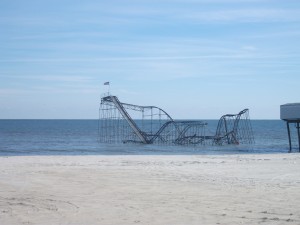For the last two or three years, if not longer, I have been engaged in an ongoing discussion with people from the U.S. Forest Service and the International Society of Arboriculture (ISA) about the role of trees in post-disaster recovery. Phillip Rodbell, an urban and community forestry program manager with the Forest Service’s Northeast office in Philadelphia, has been particularly diligent in pursuing the question of how we can better protect trees in urban areas from storms and other major disasters as well as how to reduce the loss of trees in the process of removing debris after disasters. Too often, in the absence of qualified arborists or other forestry professionals, the existing incentives for debris removal cause more, rather than fewer, trees to be cut down and hauled away than is truly necessary. The question is how to change that.
The fact that some trees, sometimes many trees, do in fact get blown down in storms, crushing cars and occasionally people, snapping utility lines, and blocking roads, fosters the false perception in some minds that trees are inevitably hazards in themselves. In fact, inadequate maintenance of the urban forest, including inadequate attention to those trees that really do pose hazards, creates problems that can be prevented with better municipal tree pruning cycles and pre-planning for more appropriate vegetative debris removal after big storms. However, local resources, including professional expertise, can be overwhelmed in a more catastrophic disaster such as a severe tornado or hurricane. The sheer number of trees blown down by Hurricane Katrina, for instance, was staggering, well into the millions.
Phil and I ultimately decided that, if the Forest Service could provide a modicum of money to help sponsor what we decided to call a scoping session, and if ISA and the American Planning Association (APA) could contribute more modestly to support the project, we could perhaps bring together a team of subject matter experts, representatives of relevant local, state, and federal agencies, and people from interested nonprofit associations, and we could foster a meaningful discussion of how to address this problem. In the process, we might help save federal, state, and local governments millions of dollars annually in avoidable debris removal costs.
This spring, we succeeded in bringing that package together and initiating a contract between the Forest Service and APA. The result was a two-day discussion held June 16-17 in APA’s Washington, D.C., offices, involving more than two dozen people, mostly in-person, but with a handful joining by conference call from remote locations in New York and Mississippi. A summary of that discussion, and the issues it addressed, is now available on the APA website, along with a bibliography of resources on the topic, and a series of briefing papers prepared by the invited experts. I invite my readers to check it out. To learn more, click here.
Jim Schwab

![999983_402895306485828_1765724132_n[1]](http://www.jimschwab.com/Hablarbooks/wp-content/uploads/2013/07/999983_402895306485828_1765724132_n1-300x225.jpg)
